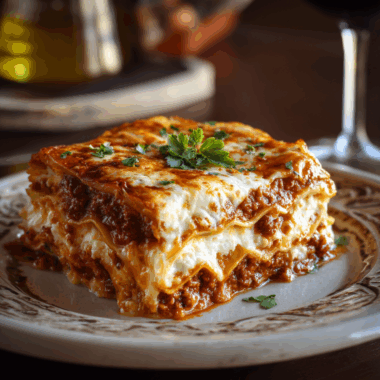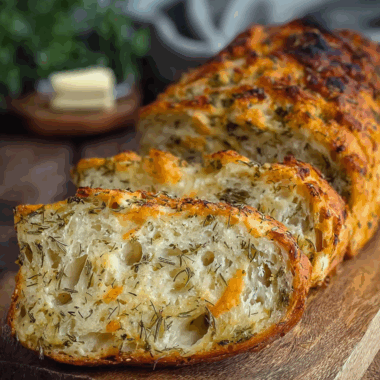Crafting homemade croissants is both an art and a rewarding ritual. The lamination process—encasing butter in dough and executing crisp folds—creates the signature flaky layers that croissants are beloved for. When baked, each croissant puffs into a golden crescent with a beautifully layered interior and a tender, melt-in-your-mouth crumb. There’s something deeply satisfying about pulling your own croissants from the oven—the aroma of baked butter and yeast fills the kitchen, and the crisp exterior gives way to tender layers with every bite. Serve them warm with jam, butter—or simply savor them plain, and let their rich, delicate texture shine.
Full recipe:
Ingredients:
-
4 cups (500 g) all-purpose flour
-
1/4 cup (50 g) granulated sugar
-
2 teaspoons instant yeast
-
1 1/4 teaspoons salt
-
1 cup (240 ml) warm milk
-
3 tablespoons (45 g) unsalted butter, melted
-
1 1/4 cups (280 g) unsalted butter, cold and flattened into a sheet
-
1 large egg, beaten (for egg wash)
Directions:
-
In a large bowl, combine flour, sugar, yeast, and salt. Add warm milk and melted butter; mix until dough forms.
-
Knead dough for 5–7 minutes until smooth, then cover and let rest for 30 minutes.
-
Roll dough into a 10×16-inch rectangle on a lightly floured surface. Place cold butter sheet in center and fold dough over it, sealing edges.
-
Roll out the dough-and-butter package into a 20×10-inch rectangle. Fold into thirds (letter fold). Wrap and chill for 30 minutes.
-
Repeat rolling and folding two more times, chilling 30 minutes between each turn. After the final fold, chill for at least 1 hour or overnight.
-
Roll dough into a 20×12-inch rectangle. Trim edges and cut into 8–12 triangles.
-
Roll each triangle from the wide end toward the tip to shape croissants. Place on a parchment-lined baking sheet, curve ends slightly to create a crescent.
-
Cover loosely and let proof in a warm spot until nearly doubled in size (about 1–2 hours).
-
Preheat oven to 400 °F (200 °C). Brush croissants with beaten egg.
-
Bake for 15–20 minutes, until deep golden and flaky. Allow to cool slightly before serving.
Prep Time: 45 minutes (plus resting/chilling/proofing time) | Cooking Time: 20 minutes | Total Time: approximately 4 hours including refrigeration | Kcal: ~300 kcal per croissant | Servings: 8–12 croissants
The History of Croissants
Croissants are one of the most iconic pastries in the world, instantly recognizable by their crescent shape and delicate flaky layers. While most people associate them with France, their origin story begins elsewhere. Historical accounts trace the earliest crescent-shaped bread back to Austria, where a pastry known as the “kipferl” was enjoyed as early as the 13th century. It was later introduced to France in the 17th century, when Viennese bakers brought their techniques to Paris. Over time, French bakers refined the recipe, using laminated dough with layers of butter and yeast-leavened dough, creating the croissant we know today.
Today, croissants have become synonymous with French culture, enjoyed in bakeries around the world. The homemade version carries on this tradition, allowing bakers to bring a piece of Paris into their kitchens. By mastering the art of lamination, anyone can recreate the buttery, golden croissant at home.
Why Homemade Croissants Are Worth the Effort
Making croissants at home is undoubtedly a labor of love, but the payoff is extraordinary. Unlike store-bought croissants, which can sometimes be dense or lack flavor, homemade croissants offer a depth of taste and texture that comes from fresh ingredients and careful technique. Each fold of butter into the dough contributes to the pastry’s signature flakiness, while the long resting times allow the dough to develop complex flavors.
Another reason homemade croissants are special is the sense of accomplishment they bring. Croissants are often seen as the pinnacle of home baking skills because they require patience, precision, and care. Pulling a tray of golden, puffed pastries out of your oven is not just satisfying—it’s proof of your dedication to the craft of baking.
The Science Behind Flaky Layers
What makes croissants so unique is the process of lamination, where butter is folded into dough multiple times to create thin alternating layers of dough and fat. When baked, the water in the butter turns to steam, puffing up the dough and creating hundreds of airy layers. This is why croissants are light and flaky on the outside but tender and slightly chewy inside.
The yeast in the dough plays an important role as well, giving the pastry its lift and subtle tang. The balance between yeast fermentation and butter lamination is what makes croissants both complex in flavor and delicate in texture.
Nutritional Benefits of Homemade Croissants
While croissants are undoubtedly indulgent, homemade versions can be more nourishing than store-bought ones. By choosing quality ingredients—such as organic flour, high-quality butter, and fresh milk—you have control over what goes into your pastry. Croissants are a source of carbohydrates for energy, along with protein and calcium from milk and butter.
When paired with fruit, eggs, or even filled with ham and cheese, croissants can become part of a balanced meal. While they’re best enjoyed in moderation, homemade croissants offer both pleasure and sustenance, making them more than just a pastry—they’re an experience.
Tips for Success When Making Croissants at Home
The most important factor in successful croissant-making is temperature control. Butter must remain cold during the folding process to create distinct layers. If it melts into the dough, the lamination will be lost, resulting in a bread-like pastry instead of a flaky one. Keeping your workspace cool and working quickly helps ensure success.
Timing is also crucial. Croissants require multiple resting periods, which allow the gluten to relax and the yeast to work its magic. Skipping or rushing these steps will compromise the texture. Planning ahead and spreading the process over two days often yields the best results.
Finally, don’t underestimate the egg wash. A light coat of beaten egg before baking gives croissants their signature golden shine and appealing bakery-quality appearance.
Creative Variations of Croissants
One of the joys of homemade croissants is experimenting with fillings and flavors. Classic variations include chocolate croissants (pain au chocolat), almond croissants filled with sweet almond cream, or ham-and-cheese croissants for a savory twist. Seasonal variations, such as pumpkin spice croissants in autumn or berry-filled ones in summer, are also a fun way to keep the recipe fresh.
You can also play with shapes. While the traditional crescent shape is iconic, croissants can be baked as straight rolls or even braided for a more artistic presentation. These small tweaks give your homemade croissants a personal touch.
Pairings and Serving Suggestions
Croissants are versatile and can be served at breakfast, brunch, or even dinner. They pair beautifully with coffee, cappuccinos, or hot chocolate for a classic café-style experience. At breakfast, they can be enjoyed plain with butter and jam, while at lunch they can be transformed into sandwiches filled with fresh vegetables, meats, or cheeses.
For special occasions, croissants can be served with champagne or sparkling wine as part of an elegant brunch spread. Their light yet rich flavor makes them suitable for both sweet and savory accompaniments, making them a staple in many cuisines worldwide.
Why This Recipe is the Best Choice for Home Bakers
This step-by-step croissant recipe simplifies a process that can seem intimidating at first. Clear instructions and practical techniques ensure that even beginners can succeed. The recipe balances technical precision with flexibility, allowing bakers to work at their own pace without compromising results.
By making croissants at home, you’re not just creating a pastry—you’re recreating an artisanal bakery experience in your kitchen. The end product is superior to most mass-produced options, with buttery richness and fresh flavor that only homemade baking can deliver.
Conclusion
Homemade croissants embody both the artistry and joy of baking. Their history connects us to centuries of tradition, while their flavor and texture bring delight in the present. Although they require time and patience, the reward is a pastry that is flaky, buttery, and truly unforgettable. Whether enjoyed on a quiet morning with coffee, served at a family brunch, or shared with friends during a celebration, homemade croissants are a timeless treat that never fails to impress. With each fold, proof, and bake, you’re not just making food—you’re creating an experience. And that’s why homemade croissants will always be worth the effort.








